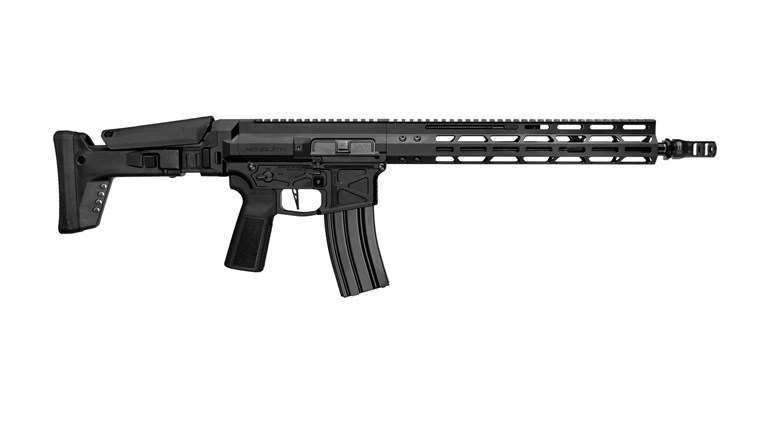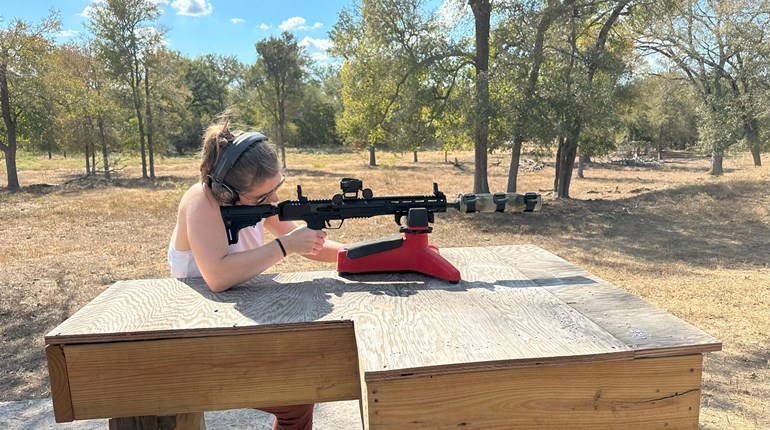
It would be interesting to slip ahead several decades to see how the history books deal with the M16 and its various derivatives. Even after four decades of service, the rifle generates comments that cover the entire spectrum of both logic and emotion. If you're interested in starting a heated discussion, and perhaps a violent argument, just mention the M16 in almost any gathering of shooters, particularly a group that includes veterans who carried the M16 in harm's way. Interestingly, there is some truth in almost every comment made, bad and good, from the charge that the rifle was some bureaucrat's pet rock to the observation that it was the first rifle to successfully reduce the soldier's load while enhancing the firepower he carried.
Whatever your opinion, consider the M16 has remained the U.S. service rifle for more than 40 years, a feat even more notable because it has occurred in an era when technology makes major systems outdated in the span of just a few years. And if you think we're about to see the AR family of rifles vanish, please explain why there are so many companies making rifles on the AR-15 platform. More specifically, why did a company like Smith & Wesson decide to leap into production of the design, putting its oldest brand name on the new rifle and calling it the M&P. That stands for "Military & Police," and embodies a reputation that has been famous and respected worldwide for more than a century. The company clearly believes rifles based on the AR platform will continue to be the choice of both the military and the police for some time to come.
Before testing at Gunsite, the M&P15 was put through the paces by a group of outdoor writers during a prairie dog shoot. Despite dusty and windy conditions, the M&P15s functioned flawlessly through the days-long shoot.A classic component of the AR-style rifle, the M&P15's high front-sight housing contains an adjustable post. Depressing a detent pin and rotating the post effects changes in elevation.
I thought every shooter must be familiar with the AR family of rifles, but there are several senior shooters (codgers, if you will) who seem to have shunned this new generation of rifles. Until a few years ago, I was a member of that group, and I now realize what a mistake that was on my part. The new M&P15 is the classic gas-operated, semi-automatic rifle in 5.56x45 mm, or .223 Remington. Both the upper and the lower receiver are manufactured from 7075 T6 aluminum. The 16-inch barrel is 4140 steel and has a 1:9-inch twist. That twist rate seems to be the best solution for handling most of the commercial ammo on the market with 40- to 62-grain bullets. For long life and wear resistance, the bore, gas key and bolt carrier are all chromed. The receiver and outer barrel have a hard-coated, black-anodized finish that is quite smooth, more so than on many other AR rifles I've seen. I'm told assembly and final fit are all done by hand, and from what I saw on the rifles I tested, I have no reason to doubt that.
The M&P15 buttstock is collapsible with a choice of six positions. At my size, and being way past the preferred age for a tactical guy, the most extended position, which gives the rifle an overall length of 35 inches, was the only choice. Even then, achieving the classic cheek weld was doubtful. That said, keep in mind this is a rifle aimed at a market where an exact cheek weld is not a primary requirement. Let me add I had very little difficulty in comfortably firing the rifle and hitting the desired target, although the trigger pull of 7 pounds required some getting used to. The basic M&P15 weighs approximately 63⁄4 pounds without a magazine and ammo, which makes for an extremely handy, if not rock-steady, package. It's a tactical rifle built for speed and mobility rather than precise offhand target shooting.
The M4-style fore-end is the elliptical-shaped handguard with vertical circumferential cuts that you've seen in all the war movies dealing with post-Korean activities. It is extremely comfortable and ergonomically satisfying; its only shortcoming being that it does not accommodate accessories. The basic M&P15 comes with the common carry handle containing an adjustable, dual-aperture rear sight, as well as a high, inverted V-shaped front sight with an adjustable post. I was surprised at how effective these sights were, even for eyes as old as mine, but the real surprise was the increased effectiveness and simplicity of converting the basic M&P15 to the M&P15A. Simply remove the carry handle to expose the integral Picatinny rail and mount the adjustable, folding rear battle sight made by Troy Industries. I did not check for accuracy with the battle sight, but I did have some fun with a number of Wyoming varmints and found the rig to be very effective inside 75 yards.
In order to master the operating controls of the M&P15, I had to overcome an old dog's aversion to learning new tricks. My rifle training involved using my trigger finger to operate both safety and trigger, or to move my thumb to the top of the stock to slide the safety on or off. The M&P15, like most members of the AR family, has a vertical grip with a selector switch on the left side of the lower receiver, which is operated by the thumb of the shooter's hand. During my early exposures to ARs, I had trouble with this switch, both in practice and as a basic operating concept. The M&P15 bolt lock and release button is also on the left side of the rifle and is operated by the thumb. Finally, the magazine-release button is on the right side of the receiver and is easily operated by the trigger finger. I am getting comfortable with the M&P15, and the fun of shooting these newfangled thunder sticks makes that effort worthwhile.
During a trip to my local range, I put a pair of M&P15A models equipped with a Leupold VX-III 1.5-5x20 mm riflescope and a Trijicon TA33R-8ACOG on paper. With Hornady 55-grain V-Max loads and Black Hills 55-grain full-metal-jacket ammo, the rifles produced groups around 1 1/2 inches at 100 yards. The range had some steel silhouette targets, and it was quite simple to whack the pig at 300 meters when using my range bag as a rest and holding the sight at the top of the pig's outline. Beyond 300 meters things got iffy, and I never really settled into a proper sight picture that produced repeatable hits. It was the same thing standing, with hits at longer ranges being very sporadic given the lack of muzzle weight. That aside, at what range should you really expect 100-percent hits from a fast-handling rifle weighing less than 7 pounds?
In addition to some range time with the M&P15, I took the rifle on several field trips. The first major outing was a varmint hunt in Wyoming at the Spur Ranch, where some of the early rifles were matched against the hordes of rodents infesting the state's open grasslands. That was followed by a couple of trips to Texas where I hunted hogs by day and called varmints by night. The final outing was a class at the Gunsite Academy, where I went through almost three days of training with the M&P15.
The Wyoming shoot featured several early models of the M&P15 and M&P15A, most of which had been equipped with various scopes, with a couple featuring the adjustable, folding sight. Keeping in mind these guns had the lightweight, 16-inch barrels, with optics I nailed prairie dogs out to around 250 yards pretty regularly. While not a 500-yard varmint rifle, the M&P15 is certainly a capable rifle at reasonable ranges. Even more fun was using iron sights on ground squirrels. These little rascals were quite abundant around the irrigated green fields and could be easily approached to within 50 or 60 yards. The Troy sight allowed a considerable number of hits to be scored with quick follow-up shots, sometimes even when the critter decided to take off after a miss. Talk about an addictive game! On a more objective note, I did not experience a single failure to function with any of the M&P15s I tried during that two-day shoot.
During the first Texas hunt, I waited in blinds for hogs and varmints. I missed a coyote right at dusk as three of them came to the pond I was watching, but made up for that a bit later by taking a handsome bobcat at the far edge of the water. Dave Biggers of XS Sight Systems took his first pig the M&P15. Biggers did not shoot from a blind, but rather stalked the pig for a few hundred yards after seeing it leave the river bottom. He was a quick convert to Smith & Wesson's black rifle, placing a couple 55-grain V-Max bullets exactly where he aimed from 60 yards.
The next stop in Texas was a visit with accomplished varmint caller Steve LaMascas of Texas Fish & Game. Equipped with our trusty M&P15s, we went out for some serious calling on several ranches. If you haven't called varmints at night, you're missing a different kind of excitement. It's much better than simply sitting in a stand and hoping for the best. The longest shot taken was in the neighborhood of 75 yards, and the M&P15s did their job flawlessly.
At Gunsite I was issued the M&P15A, only it was a special Gunsite Commemorative version with the Gunsite raven logo on the right side of the receiver. Except for the raven logo, it was just like the M&P15A with an adjustable rear sight and no carry handle mounted on the rail. The rifle had a 1X Aimpoint red-dot sight. An Aimpoint is hard to beat for a combination of rapid sight acquisition and accuracy. With range officer and instructor Giles Stock on the spotting scope and students shooting prone at a steel gong from 100 yards, sighting in was accomplished quickly. Center shots were the rule rather than the exception. Working speed drills at closer range, I became rather proficient with the Aimpoint-topped M&P15A.
One of the great attributes of the AR family is the ability to outfit the rifle with accessories that tailor it to a particular situation. I juggled some components on the M&P15 in order to handle the low-light scenarios at Gunsite. Installing SureFire rails let me mount various lights to get through the night shoots.
Smith & Wesson has done a truly nice job with its entry into the black rifle arena. The M&P15 is the embodiment of all things AR, including reliability, versatility and accuracy. Popularity is another undeniable attribute of the AR, and I have no reason to doubt the M&P15 will soon lay claim to this characteristic as well.




































